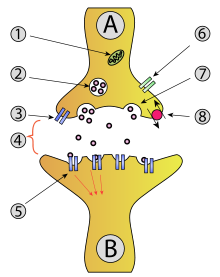Presynaptic ending

1 mitochondrion , 2 synaptic vesicles , 3 autoreceptors , 4 synaptic clefts with released unbound neurotransmitters , 5 postsynaptic receptors , 6 calcium channels , 7 exocytosis of the vesicle, 8 active transport through the cell membrane
Presynaptic terminal , and (synapse) Endknöpfchen ( French bouton terminal ) or axon terminal , i.e. the end of a neurite and axon of a nerve cell (neuron), provided that the presynaptic part of a chemical synapse forms.
The most important function of a presynaptic region or presynapse is the signal-related release of neurotransmitters . These are stored here in synaptic vesicles and are released into the synaptic gap by exocytosis when action potentials arrive from the presynaptic nerve cell . The transmitters can then be bound to specific receptors on the membrane of the postsynaptic nerve cell and lead to cellular signals ( postsynapse ).
In the so-called en-passant synapses, the presynaptic part (as bouton en passant ) is not the end of the axon, but a thickening in its course, with all the components and functions of a presynapse.
literature
- Stefan Silbernagl, Agamemnon Despopoulos: Atlas of Physiology . 5., completely revised. and redesigned edition. Thieme (dtv), Munich 2001, ISBN 978-3-13-567705-7 .